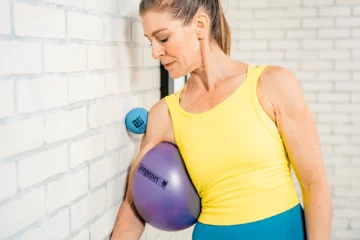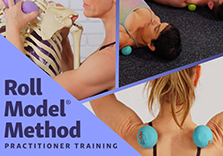
We all take sides, favoring one option over another. That includes the sides of the body. How often do you think you shift your weight from one leg to the other while waiting for the bus or spending long hours standing and chatting at a cocktail party? Just for the heck of it, do you ever try brushing your teeth with your non-dominant hand? Apart from those who are ambidextrous, being right-handed or left-handed can translate into progressive states of asymmetry in other regions of the body. I speak from anatomical experience, with years of playing the inherently one-sided sport of tennis, which can leave a noticeable imprint of upper body strength imbalance. I also endure a perennially hamstrung hamstring, a mid-body soap opera that started in January 2007. I call it the Rice Krispies Effect, when, in the midst of a seated wide-legged forward bend, I heard and felt a quick snap, crackle and pop in the upper posterior side of my right leg. Over the course of the approximate three months of right hamstring and gluteal discomfort that followed, I adopted a “suck-it-up” attitude in my yoga practice, having learned that muscle undergoing repair can form even more tightly than the previously undamaged tissue. Crude as my approach was, it worked for me. But to my chagrin, I came to realize my left hamstring was charged with taking up the considerable slack, and the ridiculously tight sensation has endured nearly four years.
I often describe yoga as “nature’s drug,” providing relief, but without – generally speaking – the disagreeable side effects. In some ways, I consider my hamstring situation a blessing to my yoga teachings. With my right leg in front, I’m able to demonstrate a split at will. With my left leg in front, I sympathize with my students who need to modify. A few key dynamic Yoga Tune Up® poses have given me – and students in similar predicaments – hope of eventually finding hip harmony.
The Half Happy Baby Minivini (video demonstration below) stretches your whole hip region dynamically. It primes the hips for yogic standing poses or for just feeling better as you move throughout your day. The movements unquestionably make anyone look goofy and appear to be having a fit. However crazy it looks, you’ll go mad for this pose.
My own take on the Psoas Spiral exercise (posted earlier this week, with a blanket held between the big and index toes) strengthens your six-pack muscles as they work hard to keep your body relatively still. It loosens and tones your hip flexors, which lack freedom in those with a history of physical trauma. The working muscle that’s the namesake of this pose attaches to the inside edge of the upper leg bone and to each lumbar vertebra, creating the potential for lower-back relief as well. You also get to reinforce the prehensile abilities of the feet. The blanket burdens the muscles with a little extra weight, building strength.
As with any effort to release chronic and deeply held tension, have patience. Know that the efforts you make now will only build toward bigger gains.
Watch our Free 5-Minute Quickfix: Hips Video
Learn about our programs for hip pain.
Learn about Yoga Tune Up at home.











We all accept asymmetry in yoga and no one expects their body to operate exactly the same on both sides – but, we too easily forget that compensation patterns create even more! You’ve helped me think about how to bring harmony to my students.
Mini-vinis rock (get it?). I have already incorporated them into classes with great effect. Thanks, Clairborne.
I am loving this minivini. It highlights discrepancies in my body and prepares it to do the activities I enjoy most.
I am loving this minivini. It’s highlighted discrepancies in my body and prepares it to do the activities I enjoy most.
Happy Baby Mini Vini is a great release of tension that I didn’t even know existed in my hips and allows for greater mobility throughout the day.
I’m starting to get the hang of this exercise. I think it may end up in my top 5 favorites. It feels so good to open up the hips and bring blood flow and oxygen into the tissues. I know my clients will benefit greatly. I just did them on both sides and I personally feel so much more open in my hip flexors, adductors and quadradus lumborum.
I continue to catch myself putting my weight all to one side when standing and have to snap myself back to neutral. Half happy baby is such a great relaxing pose and offers instant relief to tight hips.
Due to it’s fullness of range of motion the Half Happy Baby Mini-vini appears to be the go to dynamic pose for many hip concerns. The pose makes me feel somewhat successful for it allows some imperfections such as lifted hip when going into leg stretch #2, and extended leg not so straight.
It never ceases to amaze me just how different the two sides of the body can be (or become) with repetitive stress, overuse, underuse, or favoring one side over the other. Your article is a clear reminder of some of the imbalances I have created in my own body over the years – favoring my more flexible side in practice and by demonstrating postures on that side while teaching. So I’m taking action and doing something about it! I also am a new fan of the Psoas Spiral exercise! It’s helping me tremendously with my core strength while assisting the process of bringing my hips back into balance. Thanks for the great post!
I have had tremendous hip pain recently (that could also be contributed to by the dominance of my practicing judo throws on one side) and found that Happy Baby Minivini was just the dynamic stretch that I needed.
Thank you for your post. I find asymmetry in the hips to be very prevalent in my body. The left hip is tighter than the right and causes pain in my left gluteals during practice. As a hip warm up half happy baby minivini is a favorite, the range of motion it offers the hips has helped stretch and strengthen my gluteal muscles. Doing this pose over several minutes lubricates the hip joint and allows ease and symmetry in my yoga practice.
I love the happy baby mini vini! It has really helped me with a piriformis issue as the stretch has been very effective and unlocking that muscle. It is also nice to have one of the YTU adjustments in half happy baby to get a deeper stretch. I love the full range of motion the hip socket receives from this pose too. Thanks for the blog!
I really love the half baby mini vini….it’s like taking a key and unlocking your hips giving them freedom that translates to your entire body! It’s a juicy, fun, smile-inducing pose that I will never be without.
So did your hamstring attachment completely detach from the ishial tuberosity or was it a tear? Just curious and was wondering if you had any deep tissue or myofascial work to break up scar tissue etc? I love this sequence, we just learned it yesterday in level 1 yoga tuneup training. Found it harsh on my SI joint (which has been out of wack) with the block.
One of my favorite mini vinis! I love how my hips feel after , exhilarated and free. I know my unbalanced strength and flexibility in my adductors and hamstrings have held me back from many poses that I am now finding freedom in thanks to Jill and YTU. Happy Baby Mini vini and YTU inspired poses have inspired bliss in my hip flexors and indulgence in my adductors.
I have a definite imbalance in my hamstring flexibility from right to left. It is sometime subtle and sometimes more obvious. I have only tried the happy baby minivini once but i think with time and patience i will be able to harmonize my hips in this pose. My concern is in overstretching the tendon rather than getting into the belly of the hamstring, I love how YTU does not accept the usual excuses i give myself! i need to take responsibility to learn the appropriate sensations and find my best alignment. Thank you YTU
Happy Baby pose has been a favorite of mine for many years and my students love it also. I’m so excited about learning the PNF to help people go deeper into the pose (1/2 Happy Baby that is) and I know this will become a wonderful way to teaching people to heal themselves and relieve all that hip pain out there.
Half Happy baby minivini rocks. Seriously! I have been doing them for a while, I have taught them to others and we are all getting addicted! Well, that could be a problem…. As addictions go, this one is fantastic. When I do not include this minivini in a class, someone inevitably will give me a look “well…???? Now????
Very helpful, not overly complicated, and much fun to watch (and listen too… 😉
Half Happy Baby Mini-Vini is one of my most favourite poses in YTU.It creates a very profound state in the whole hip,literally flushing out the stagnant energy and re-creating life in the pockets that might have become overused due to the overreliance on sitting that we carry within our culture.